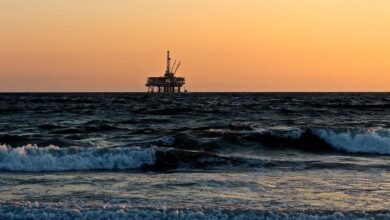Will copper unleash a new commodities ‘supercycle’? – DW – 05/10/2024

For most of the past two years, the global price of copper languished in the doldrums, barely fluctuating around the level of $8,500 (€7,890) for a ton, and being largely ignored by commodities traders. Since April this year though, the metal is back in the focus of investors after surging to a fresh 2-year high of $10,110 at the London Metal Exchange (LME) on April 30.
“Index funds, exchange-traded funds, etc, are attracting retail money into metals. Momentum-based buying is pulling them up; selling resistance remains low,” Sandeep Daga, a director at metals analysis company Metal Intelligence Centre, told news agency Reuters. He warned at the same time that the metal is “filled with the spirit of excitement, which is taking it far away from the reality.”
The current reality, indeed, is that global growth is weakening, meaning copper prices should actually come under pressure because of falling demand — a correlation that’s been valid throughout history. But why does it seem to be different this time around? And why are some experts even speaking of the beginning of a new so-called commodities supercycle, led by copper?
A commodities supercycle refers to an extended period of rising prices for commodities across various sectors, driven by sustained demand growth, supply constraints, and broader economic factors.
The last commodities supercycle — including iron ore, agricultural products and minerals — began around the early 2000s and lasted until around 2014/2015. It was fueled by rapid industrialization and urbanization in emerging economies like China.
Copper — the base metal of electrification
At the moment, investors’ fresh enthusiasm for copper is caused by its key role in global efforts to move away from fossil fuels towards energy systems based on renewables.
Joachim Berlebach, the founder and CEO of Earth Resource Investments in Zurich, says the metal is indispensable for electrification “due to its physical properties, especially its electrical conductivity.”
“If we really want to move away from fossil fuels, we would need approximately the same amount of copper in the next three decades as in the entire previous history of mankind,” he told DW.
Michael Widmer, commodity strategist at the Bank of America (BofA), also thinks global decarbonization efforts are currently driving the price rally of copper. “Copper is used in almost every industry and is therefore considered an economic indicator,” he told German business daily Handelsblatt recently.
Supply shortage caused by exploration slump
Both Berlebach and Widmer agree that the recent surge in copper prices is primarily the result of rising demand amid stagnating or even decreasing supplies following the end of the supercycle about a decade ago. “Due to the lack of investments in new mines … there are not enough copper mines,” said Berlebach.
Widmer calculated that investment in new mines must reach “at least $127 billion per year” in order to keep up with annual copper demand until 2050, as estimated by the International Energy Agency (IEA). “But last year, it was only $104 billion,” he added.
The BofA expert sees no quick solution to lagging copper supply as building new mines “often encounters resistance,” due to their environmental burden. In the interview for Handelsblatt, he cited the recent closure of Panama’s largest copper mine as an example, run by Canadian mining company First Quantum. “Initially, there was only a conflict between the government and First Quantum, then protests erupted among the local population. Ultimately, the government closed the mine and said it would not come back onto the market.”
Berlebach also believes copper production cannot be ramped quickly “because it takes up to 15 years from the first drill hole to production,” adding that often “falling ore grades [mean] new mines also have to be designed larger.”
Costly copper is here to stay
The days of copper production in Germany are long gone, although some deposits still exist in some regions where the metal was mined several centuries ago.
Berlebach thinks domestic exploration and extraction is “relatively unproductive, and only theoretically possible.” Operating large-scale mines in Germany, in general, would involve “lengthy bureaucratic processes” which is why the country would continue to depend on “deposits in South America and Congo.”
He also sees no metals alternative to copper like, for example, aluminum. He said it can neither be used for landlines nor coils in wind turbines or electric cars. “Aluminum has only about 65% of the conductivity of copper — the cables will become too thick.”
BofA analyst Michael Widmer, therefore, believes copper prices will remain elevated. “Of course, there may be short-term corrections, but in the long term, I see prices rising.” Widmer told Handelsblatt the metal may even experience “what is likely to be a long-lasting supercycle.”
In the global hunt for copper, the Norwegian government now even wants to mine minerals from the seabed off its coast. Last year, it reported “significant amounts of mineral resources” in Norwegian waters, including deposits of zinc, cobalt and copper.
This article was originally written in German.





